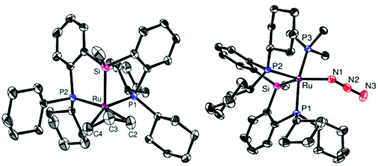Synthesis and characterization of five-coordinate, 16-electron RuII complexes supported by tridentate bis(phosphino)silyl ligation†
Abstract
The synthesis of 16-electron complexes of the type (Cy-PSiP)RuX(L) (Cy-PSiP = κ3-(2-Cy2PC6H4)2SiMe) is reported. Treatment of (Cy-PSiP)H with one equiv. RuCl2(PPh3)3 in the presence of Et3N afforded a mixture of (Cy-PSiP)RuCl(PPh3) (1) and [(Cy-PSiP)RuCl]2 (2), which exists in a temperature-dependent equilibrium process involving reversible dissociation of PPh3 from 1 to form 2. While treatment of this equilibrium mixture with PMe3 afforded (Cy-PSiP)RuCl(PMe3) (3) cleanly, this product was more straightforwardly prepared by the addition of PMe3 to 2 (97% yield). Attempts to form an alkyl complex of the type (Cy-PSiP)RuMe(PMe3) via treatment of 3 with MeMgBr led to the dehydrogenation and cyclometalation of a cyclohexyl phosphino group to give the isolable 18-electron complex [MeSi(C6H4PCy2)(C6H4PCy(η3-C6H8))]RuPMe3 (4, 78% yield). The hydrido complex (Cy-PSiP)RuH(PMe3) (5) was identified as a minor by-product in this dehydrogenative process. Whereas simple 16-electron alkyl complexes of the type (Cy-PSiP)RuR(PMe3) remained elusive, the isolable allyl complex (Cy-PSiP)Ru(η3-C3H5) (9) was successfully prepared from 2 and (C3H5)MgCl (79% yield). Treatment of 3 with Me3SiN3 or NaN3 did not generate a five-coordinate azido species. However, the putative dinuclear complex [(Cy-PSiP)RuN3]2 (10) was observed to react with one equiv. of PMe3 to afford the isolable five-coordinate azido complex (Cy-PSiP)Ru(N3)(PMe3) (11; 94% yield). Crystallographic data for 3, 4, 5, 9 and 11 are presented.

- This article is part of the themed collection: Reactions Facilitated by Ligand Design

 Please wait while we load your content...
Please wait while we load your content...